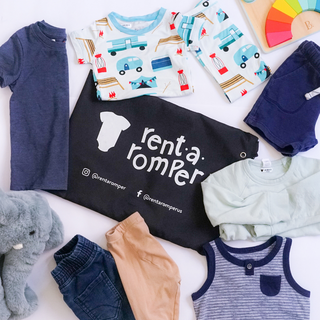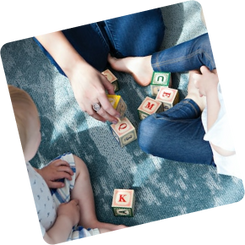baby clothes
October 15, 2022
NEW, THRIFT OR RENT? HOW TO SNAG SUSTAINABLE BABY CLOTHING
Written by Rent a Romper customer and mom, Dara Smith
From feeding to that mythical sleep schedule, there’s much to consider when bringing a baby home. Not to mention all the items you may (or may not) need for parenting success. Maybe you're sampling bottles, testing bassinets and adding cuddly rompers to your registry. Or perhaps you’re researching every ingredient in your kiddo’s meals. Either way, it’s easy to get caught up in the endless details and decisions related to growing a family.
Don’t stress. It's only natural to gravitate toward whatever can make your life more convenient (and adorable). But as you gear up for your bundle of joy, you can stock their closet while minimizing environmental harm. Whether you’re buying new, thrifting or renting, we’re covering all the basics of sustainable shopping for your latest addition.
Ways to shop for sustainable kids’ clothing
With a $63 billion dollar price tag*, the baby clothing industry is bigger than ever. So, there’s no shortage of outfit options for your cutie. But keeping their style climate-friendly might take a little more TLC. So, here are three ways to shop sustainably for your babe along with their pros and cons.
- Buy new. From big-name retailers to Direct-to-Consumer brands, buying new can deliver your desired styles and sustainability features at any price.
- Thrift or consign. Whether it’s a cameo at a thrift shop or a scan of a children’s resale site, you can snag stellar items at a fraction of the cost of purchasing new.
- Rent. In today’s sharing economy, baby clothes subscription boxes are all the rage. Rental companies let you borrow preloved clothes before requesting your next supply.
1. Buy new organic clothes

Shopping for new baby clothes can be so much fun. Who can resist those tiny mittens or a ruffle-butt bodysuit? But before loading your shopping cart, consider the pros and cons of purchasing new.
Pros of buying new baby clothes:
- Quality and style control. Whether it’s a neutral color palette or a natural fiber rule, your baby's needs can make the wide selection of new clothing appealing. You’re also less likely to get damaged or faded pieces when purchasing something fresh.
- Selection. Committing to sustainability isn’t a one-time decision. It means choosing it time and time and again. While researching new, organic baby garments, you can ensure your selection supports your beliefs.
- Peace of mind. There’s something comforting about zipping your babe into a never-been-worn all organic getup. You don’t need to worry about where it’s been or what it’s been through before touching your sweetie’s soft skin.
Cons of buying new baby clothes:
- Price. Investopedia says you can expect to spend about $60/month on baby clothes. And if you’re purchasing luxury or specialty items that price escalates quickly. What It Costs estimates that organic materials and “eco-friendly” garments can cost up to $40/article (or even more). So, deciding to go green can be pricy for many families who love their kids in new attire.
- Environmental harm. Bloomberg says that over 11 million tons of textiles are tossed into landfills each year. And with more clothing in production than ever, this alarming number only increases. So, even if a brand manufactures its babywear eco-consciously, its additional output still impacts the earth.
- Accumulation. Babies grow (and outgrow) clothing fast. Just when they’ve settled into one size, they’re ready for the next. To keep up with their development, you’ll need to stock up on sizes and styles, which could lead to a surplus of stuff crowding your precious space.
2. Shop at thrift or consignment stores

Anyone game for a good bargain knows the thrill of thrifting or consigning. Baby resale destinations make secondhand scores possible for deal-hungry parents. But when predictability is key to family planning, the challenges of thrifting or consigning could overshadow its joys.
Pros of shopping thrift:
- Price. Investopedia recommends that consignment sellers discount their items 50% to 70% off their retail values. That means huge savings for those with the time and patience to sort through preloved apparel.
- Environmental impact. If the goal in sustainable fashion is landfill diversion, thrifting supports that mission. Studies show that by extending a garment’s life for just nine months, you can reduce its water, waste and carbon footprint by up to 30%**. So, reuse in any form is a great eco-friendly option.
- Support for families/small businesses. Whether shopping in person or online, your investment can help individuals and small businesses instead of corporations.
Cons of shopping thrift:
- Selection. Most parents can attest that when shopping for littles, you search for what you need. So, the unpredictable inventories of thrifting or consigning can make your hunt more daunting. To ease your anxiety, approach each site with creativity and a flexible attitude to get the most bang for your buck.
- Value. The price might be right, but a resold garment’s value often diminishes when it hits the shelves. The New York Times blames fast fashion for flooding thrift shops with low-quality pieces likely to deteriorate. And to keep up with your little’s lifestyle, you’ll need a wardrobe built to last.
- Environmental harm. Although reuse supports sustainability, The New York Times also says overproduction has made it impossible for thrift shops to keep up with their growing inventories. So, resource-light businesses likely send excess goods to landfills, continuing the cycle of fashion waste and overproduction.
3. Rent baby clothes and swap when you need new sizes
So, buying new clothes can be expensive, and thrifting might not be everything you hoped. Not to mention, both options are time consuming, especially since your baby is constantly growing and always needs new clothes! Luckily, the third option for dressing littles combines the best of both worlds—without all the hassle. Baby clothes subscriptions (like Rent-a-Romper) offer low-investment, high-quality rentals that break the cycle of fashion overproduction.
Pros of renting baby clothes:
- Price. Forget your $60 monthly dressing budget. Instead, you can style your mini in full for $24 with a Rent-a-Romper Essentials Capsule. Each membership includes seven to 15 must-have items to mix and match into all the outfits your baby needs.
- Selection. With over 200 brands in our inventory and sizes ranging from preemie to 5T, you’ll never be left in the lurch. Also, our customized style quiz and customer support teams help curate your capsule to fit your family’s requests.
- Convenience. Instead of hoarding sizes or stalking exchange groups, Rent-a-Romper lets you swap items whenever you want. Just fill out the form and enjoy your kids while your stylist sets up your next capsule.
- Environmental impact. At Rent-a-Romper, sustainability is at the heart of everything we do. We save thousands of gallons of water and hundreds of pounds of waste by sharing outfits with our community and donating to recycling partners. So, you can rest easy knowing your cutie’s rocking wardrobe helps the planet, too.
Cons of renting baby clothes:
- We're biased, but we don't really see any cons to renting! You'll always have sustainable clothes, in the right sizes and styles, at a great price and without doing all the work! However, if you prefer to dress your little one in all new clothes, then renting might not be right for you.
Shop, thrift or rent? Which one will you choose?

There’s no right way to parent, and there’s no right way to shop. So, whether you’re buying all new organic clothes, or re-using the existing clothing supply via thrifting or renting, your efforts to stay sustainable make a difference. Want help to make your sustainable efforts go a bit further? A monthly Rent-a-Romper membership can offer extra support.
So, what do you think? Are you ready to try your first capsule collection? It’s a great way to dip your toes into the world of baby and toddler clothing rentals. And if you fall in love, you can add more memberships, savings and sustainable shopping fun. And if you're expecting, we've even made it easy for you to add Rent-a-Romper to your baby registry.

























